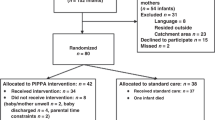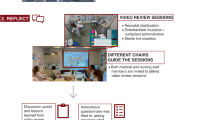Abstract
Objective:
The objective of the study is to develop and validate a video-based parental decision aid about the outcomes of extremely premature infants.
Study Design:
Thirty-one clinicians and 30 parents of extremely premature infants (<26 weeks gestation) previously underwent semi-structured interviews to assess perceptions of antenatal counseling. Interviewees recommended a video. A video was iteratively developed, with final validation by three groups: clinicians (n=16), parents with a history of extreme prematurity (n=14) and healthy ‘naïve’ women without prior knowledge of prematurity (n=13). Two iterations of the video were created. Following a simulated counseling session, an eight-question survey and the State-Trait Anxiety Inventory (STAI) were administered to parents and ‘naïve’ participants to assess usefulness and stress provocation.
Results:
The final 10-min video shows six children/parent dyads of former 23 to 25 week premature children with a wide range of outcomes. This video was well accepted by clinicians as well as parent and ‘naïve’ participants, who perceived it as ‘balanced’ with a ‘neutral’ message. The video was felt to provide useful information and insight on prematurity. The final version of the video did not induce anxiety: parents STAI-S 36.1±12.1; ‘naïve’ 30.2±8.9.
Conclusions:
A short video showing the range of outcomes of extreme prematurity has been produced. It is well accepted and does not increase levels of anxiety as measured by the STAI. This video may be a useful and non-stress-inducing aid at the time of counseling parents facing extreme prematurity.
This is a preview of subscription content, access via your institution
Access options
Subscribe to this journal
Receive 12 print issues and online access
$259.00 per year
only $21.58 per issue
Buy this article
- Purchase on Springer Link
- Instant access to full article PDF
Prices may be subject to local taxes which are calculated during checkout
Similar content being viewed by others
References
Raju TN, Mercer BM, Burchfield DJ, Joseph GF . Periviable birth: executive summary of a Joint Workshop by the Eunice Kennedy Shriver National Institute of Children Health and Human Development, Society for Maternal-Fetal Medicine, American Academy of Pediatrics, and American College of Obstetricians and Gynecologists. J Perinatol 2014; 34 (5): 333–342.
Boss RD, Hutton N, Sulpar LJ, West AM, Donohue PK . Values parents apply to decision-making regarding delivery room resuscitation for high-risk newborns. Pediatrics 2008; 122: 583–589.
Harrison H . The offer they can't refuse: parents and perinatal treatment decisions. Semin Fetal Neonatal Med 2008; 13 (5): 329–334.
Zupancic JA, Kirpalani H, Barrett J, Stewart S, Gafni A, Streiner D . Characterising doctor-parent communication in counselling for impending preterm delivery. Arch Dis Child Fetal Neonatal Ed 2002; 87 (2): F113–F117.
Gaucher N, Payot A . From powerlessness to empowerment: mothers expect more than information from the prenatal consultation for preterm labor. Paediatr Child Health 2011; 16 (10): 638–642.
Muthusamy AD, Leuthner S, Gaebler-Uhing C, Hoffmann RG, Li SH, Basir MA . Supplemental written information improves prenatal counseling: a randomized trial. Pediatrics 2012; 129 (5): e1269–e1274.
Kakkilaya V, Groome LJ, Platt D, Kurepa D, Pramanik A, Caldito G et al. Use of a visual aid to improve counseling at the threshold of viability. Pediatrics 2011; 128 (6): e1511–e1519.
Guillen U, Suh S, Munson D, Posencheg M, Truitte E, Zupancic J et al. Development and pretesting of a decision-aid to use when counseling parents facing imminent extreme premature delivery. J Pediatr 2012; 160 (3): 382–387.
O'Connor AM, Bennet CL, Stacey D, Barry M, Col NF, Eden KB et al. Decision aids for people facing health treatment or screening decisions. Cochrane Database Syst Rev 2009; (3): CD001431.
Volandes AE, Passasche-Orlow MK, Barry MJ, Gillick MR, Minaker KL, Chang Y et al. Video decision support tool for advance care planning in dementia: randomised controlled trial. BMJ 2009; 338: b2159.
El-Jawahri A, Podgurski LM, Eichler AF, Plotkin SR, Temel JS, Mitchell SL et al. Use of video to facilitate end-of-life discussion with patients with cancer: a randomized trial. J Clin Oncol 2010; 28: 305–310.
Volandes AE, Barry MJ, Chang Y, Passasche-Orlow MK . Improving decision making at the end of life with video images. Med Decis Making 2010; 30 (1): 29–34.
Volandes AE, Lehmann LS, Cook EF, Shaykevich S, Abbo ED, Gillick MR . Using video images of dementia in advance care planning. Arch Intern Med 2007; 167 (8): 828–833.
Volandes AE, Mitchell SL, Gillick MR, Chang Y, Paasche-Orlow MK . Using video images to improve the accuracy of surrogate decision-making: a randomized controlled trial. J Am Med Dir Assoc 2009; 10 (8): 575–580.
McCannon JB, O’Donnell WJ, Thompson BT, El-Jawahri A, Chang Y, Ananian L . Augmenting communication and decision making in the intensive care unit with a cardiopulmonary resuscitation video decision support tool: a temporal intervention study. J Palliat Med 2012; 15 (12): 1382–1387.
Crabtree BF, Miller WL . Doing Qualitative Research. 2nd edn Sage Publications: Thousand Oaks, CA, USA, 1999.
Miles MB, Huberman AM . Qualitative Data Analysis: A Sourcebook of New Methods. 2nd edn Sage Publications: Thousand Oaks, CA, USA, 1994.
Spielberger C, Gorsuch R, Lushene R . STAI Manual for the State-Trait Anxiety Inventory. Consulting Psychologists Press Inc: Palo Alto, CA, USA, 1970.
Hulac P . Creation and use of You Are Not Alone, a video for parents facing difficult decisions. J Clin Ethics 2001 Fall 12 (3): 251–253.
Carey M, Schofield P, Jefford M, Krishnasamy M, Aranda S . The development of audio-visual materials to prepare patients for medical procedures: an oncology application. Eur J Cancer Care 2007; 16: 417–423.
Haward MF, Murphy RO, Lorenz JM . Message framing and perinatal decisions. Pediatrics 2008; 122 (1): 109–118.
Elwyn G, O’Connor A, Stacey D, Volk R, Edwards A, Coulter A et al. Developing a quality criteria framework for patient decision aids: online international Delphi consensus process. BMJ 2006;; 333 (7565): 417.
Volandes AE, Paasche-Orlow MK, Mitchell SL, El-Jawahri A, Davis A, Barry MJ et al. Randomized controlled trial of a video decision support tool for cardiopulmonary resuscitation decision making in advanced cancer. J Clin Oncol 2013; 31 (3): 380–386.
Robertson C, Gatchel RJ, Fowler C . Effectiveness of a videotaped behavioral intervention in reducing anxiety in emergency oral surgery patients. Behav Med 1991; 17: 77–85.
McDaniel RW, Rhodes VA . Development of a preparatory sensory information videotape for women receiving chemotherapy for breast cancer. Cancer Nurs 1998; 21: 143–148.
Luck A, Pearson S, Maddern G, Hewett P . Effects of video information on precolonoscopy anxiety and knowledge: a randomized trial. Lancet 1999; 354: 2032–2035.
Acknowledgements
We thank Judy Bernbaum and Jo Ann D’Agostino for facilitating patient recruitment at the Children’s Hospital of Philadelphia. This project was done with no specific support.
Author information
Authors and Affiliations
Corresponding author
Ethics declarations
Competing interests
The authors declare no conflict of interest.
Rights and permissions
About this article
Cite this article
Guillén, Ú., Suh, S., Wang, E. et al. Development of a video decision aid to inform parents on potential outcomes of extreme prematurity. J Perinatol 36, 939–943 (2016). https://doi.org/10.1038/jp.2016.127
Received:
Revised:
Accepted:
Published:
Issue Date:
DOI: https://doi.org/10.1038/jp.2016.127
This article is cited by
-
Early antenatal counseling in the outpatient setting for high-risk pregnancies: a randomized control trial
Journal of Perinatology (2021)
-
Prenatal consults with illustrated literature (PnCIL): a RCT studying visual aids during prenatal consults
Journal of Perinatology (2020)
-
Creation of a Decision Support Tool for Expectant Parents Facing Threatened Periviable Delivery: Application of a User-Centered Design Approach
The Patient - Patient-Centered Outcomes Research (2019)
-
Constructing a Culturally Informed Spanish Decision-Aid to Counsel Latino Parents Facing Imminent Extreme Premature Delivery
Maternal and Child Health Journal (2018)
-
Professionals’ preferences in prenatal counseling at the limits of viability: a nationwide qualitative Dutch study
European Journal of Pediatrics (2017)



